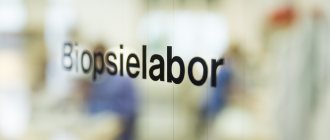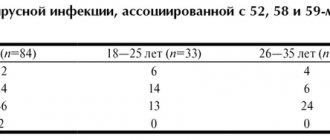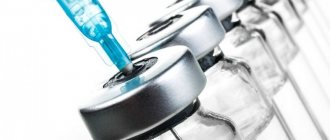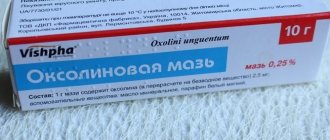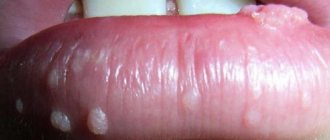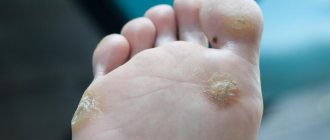The human papillomavirus (HPV) is ubiquitous and causes a wide range of benign lesions of the skin and mucous membranes, while playing an important role in the pathogenesis of malignant neoplasms, in particular squamous cell cancer of the skin, cervix, penis, areola of the mammary gland, etc. [ 12]. To date, more than 150 types of HPV have been described. According to some data, HPV infection among the adult population is 20–60% [2]. According to the Center for Infectious Disease Control (Atlanta, USA), genital warts and condylomas, the causative agents of which are various types of HPV, affect about 630 million people in the world, and the prevalence of HPV is 3 times higher than genital herpes and is not inferior to gonorrhea [4 ]. It is estimated that more than 75% of sexually active men and women have been infected with at least one type of HPV during their lifetime [3].
Diseases caused by HPV currently include warts, genital warts, epidermodysplasia verruciformis, papillomas, some precancerous diseases and forms of cancer (see above) [4]. The first two diseases are the most widespread. For example, simple warts are detected in 20% of schoolchildren, genital warts in developed countries are the most common sexually transmitted diseases [1], and among patients seeking help in gynecological clinics, 44.3% of women are infected with HPV [1, 5, 9].
In connection with the above, the search for effective methods of treating patients with HPV infection is an urgent problem for all countries of the world.
Today, practitioners have many methods for treating diseases caused by HPV, such as anogenital warts. The effectiveness of these treatment approaches varies from 30 to 90%, but none of them can be considered optimal, since the relapse rate even with the most modern methods is 15–20%. It has been established that the inclusion of immunostimulating drugs in the complex of treatment measures increases the effectiveness of therapy, although it does not completely solve the problem [6–9].
The purpose of this study was to evaluate the effectiveness and safety of including the immunostimulating and antiviral drug Isoprinosine (inosine pranobex) in standard complex therapy for patients with warts and genital warts.
Material and methods
The study included 78 patients, including 47 men and 31 women. In 3 patients, common warts were detected, in 6 – palmoplantar warts, in 3 – flat warts, in 66 – genital warts (see table).
. Nosological composition and gender of patients.
Inclusion criteria:
- clinically verified diagnosis of warts or genital warts;
- age 3 years and older;
- availability of informed consent to participate in the study of the patient or his parents. Exclusion criteria:
- urolithiasis, cardiac arrhythmia, renal failure, pregnancy and lactation;
- age up to 3 years;
- individual intolerance to Isoprinosine.
Criteria for the effectiveness of treatment (recovery):
- complete resolution of all elements of the rash;
- no relapses during the observation period (9 months).
The largest group – 66 (84.6%) people – were patients with genital warts. They were distributed by age as follows: up to 17 years old – 6, 18–20 years old – 16, 21–25 years old – 19, 26–30 years old – 9, 31–35 years old – 11, 36–40 years old – 4, 41–50 years – 1 patient. Thus, 50 patients (75.8% of the total number in the group) became infected before the age of 30 years. Married (10 people) and married (15 people) in this group made up 37.9%. Fifteen patients (22.7%) had previously received treatment for genital warts (Cycloferon, Allokin-alpha, Feresol, cryodestruction), but they developed a relapse. Of the concomitant diseases in the group, trichomoniasis (19 people - 28.8%), gonorrhea (2 people - 3.0%), chlamydia (8 people - 12.1%), vaginal candidiasis (13 people - 19.7%) were identified. .
As part of the complex treatment, cryodestruction of rashes was used (using the Azocryod apparatus); Isoprinosine (Teva) 1000 mg (2 tablets) 3 times a day after meals in combination with the local cytotoxic drug podophyllotoxin (Condilin).
For common and flat warts, cryodestruction of the elements was carried out on the 5th day while taking Isoprinosine for 10 days.
For palmoplantar warts (out of 6 patients, four had previously received laser therapy - 1, cryodestruction - 1, feresol - 2), cryodestruction of elements was carried out on the 5th day while taking Isoprinosine for 10 days, then after an 8-day interval another one was performed 10-day course of treatment (the lesions were lubricated with Panavir gel after treatment).
For genital warts, cryodestruction was performed while taking isoprinosine: three 5-day cycles at monthly intervals.
The duration of general observation of patients was 9 months.
results
In patients with common and flat warts, there were no relapses after treatment (efficacy - 100%); out of 6 patients with palmoplantar warts, a relapse occurred in 1 patient (efficacy - 83.4%), he was given an additional course (cryodestruction + Isoprinosine), after which a clinical cure occurred.
Among patients with genital warts, 3 people did not appear for a follow-up examination after the course of treatment, and of the remaining 63 patients, complete clinical cure was achieved in 59 cases (efficacy - 93.6%). Relapses were registered in two women during pregnancy and in two patients who admitted casual unprotected sex after treatment. As a result of an additional course of complex treatment, they achieved clinical recovery.
The overall effectiveness of treatment in the entire group of observed patients who completed the study (75 people) was 93.3%.
Treatment was generally well tolerated: of the total number of patients, 1 (1.3%) patient complained of nausea, and 2 (2.7%) complained of lethargy and drowsiness. Isoprinosine discontinuation was not required in any of the cases. There were also no changes in routine blood tests, urine tests, uric acid levels, transaminases and creatinine.
conclusions
- The inclusion of Isoprinosine in the complex treatment of patients with common, palmoplantar, flat warts and genital warts ensured recovery of the vast majority of patients (93.3%).
- Treatment with Isoprinosine is well tolerated; rare adverse events (in 4% of patients) do not require discontinuation of the drug.
- Isoprinosine therapy in combination with destructive treatment methods can be recommended for diseases caused by HPV, primarily for patients with genital warts.
Information about the authors: Alexey Yuryevich Rodin – Doctor of Medical Sciences, Professor, Head of the Department of Dermatovenerology, Volgograd State Medical University. Tel. 36-13-88, E-mail; Zaklyakova Tatyana Nikolaevna – deputy chief physician of the Krasnooktyabrsky dermatovenous dispensary in Volgograd
Pharmacological properties of the drug Isoprinosine
Pharmacokinetics. Isoprinosine is an antiviral agent with immunomodulatory properties. The drug normalizes the deficiency or dysfunction of cellular immunity, inducing the maturation and differentiation of T lymphocytes and T1 helper cells, potentiating the induction of a lymphoproliferative response in mitogenic or antigen-active cells. Isoprinosine models the cytotoxicity of T-lymphocytes and natural killer cells, the function of T8 suppressors and T4 helpers, and also increases the amount of immunoglobulin G and surface complement markers. Isoprinosine increases the synthesis of interleukin-1 (IL-1) and the synthesis of interleukin-2 (IL-2), regulates the expression of IL-2 receptors. Isoprinosine significantly increases the secretion of endogenous γ-interferon and reduces the production of interleukin-4 in the body. Isoprinosine enhances the effect of neutrophilic granulocytes, chemotaxis and phagocytosis of monocytes and macrophages. Isoprinosine inhibits the synthesis of the virus by incorporating inosine-orotic acid into the polyribosomes of the virus-affected cell and inhibiting the attachment of adenylic acid to the viral mRNA. Pharmacokinetics. After oral administration at a dose of 1.5 g, the maximum concentration of inosine pranobex in the blood plasma is reached after 1 hour and is 600 mcg/ml. In the body, inosine pranobex is metabolized in the liver to form uric acid. The half-life of 4-(acetylamino)benzoate is 50 minutes, 1-(dimethylamino)-2-propanol is 3.5 hours. It is excreted by the kidneys in the form of metabolites.
Use of the drug Isoprinosine
Prescribed orally; the daily dose depends on the patient's condition. Adults and children over 12 years of age: 50 mg/kg body weight (6–8 tablets) in 3–4 doses per day; for children - 50–100 mg/kg in 3–4 doses. The course of treatment is 5–10 days, the maximum daily dose is 4 g. Children aged 1–12 years: 50 mg/kg body weight (1 tablet per 10 kg body weight for a child weighing 10–20 kg, with body weight over 20 kg - an adult dose is prescribed) in 3-4 doses, the maximum daily dose is 4 g. To make swallowing easier, the tablet can be crushed. For diseases caused by Varicella zoster (including chickenpox), measles, mumps virus, acute viral hepatitis and acute respiratory viral diseases, the course of treatment is 5–14 days. After the intensity of the symptoms of the disease has decreased, treatment is continued for 1–2 or more days, depending on the symptoms. For diseases caused by cytomegalovirus, Epstein-Barr virus, treatment is continued for 1-2 weeks after the intensity of symptoms has decreased, or more, depending on the symptoms. In cases of relapse of the disease caused by the Herpes simplex , 6–8 tablets are prescribed. in 3–4 doses per day. After the intensity of symptoms decreases, a maintenance dose of the drug is prescribed - 1-2 tablets. per day. The course of treatment is 5–14 days. For chronic viral hepatitis, chronic respiratory diseases, in patients under stress, with immunodeficiency states, the drug is prescribed in a daily dose of 50 mg/kg body weight in accordance with the following schemes: asymptomatic diseases: take the appropriate dose for 30 days with a break of 60 days; diseases with moderately severe symptoms: taken for 60 days with a break of 30 days; diseases with severe symptoms: for 90 days with a break of 30 days. The course of treatment should be repeated as many times as necessary, with constant monitoring of the patient's condition and the reasons for continuing therapy. For subacute sclerosing panencephalitis, the daily dose is 100 mg/kg, the maximum is 4 g/day for long-term use. In particularly severe cases, the recommended daily dose may be increased. For infections caused by the human papillomavirus, 3 g/day (2 tablets 3 times a day) is prescribed as an addition to local therapy or surgery according to the following regimens:
- for 14–28 days for low-risk patients, then a break until the end of the 2nd month to achieve the maximum level of viral eradication;
- 5 days per week consecutively for 1–2 weeks per month for high-risk patients for 3 months.
The following conditions are considered high risk in patients with recurrent or cervical dysplasia:
- papillomavirus infection of the genital organs, which lasts more than 2 years or 3 or more relapses in history;
- immunodeficiency resulting from a recurrent or chronic disease, or diseases that are sexually transmitted;
- chemotherapy;
- chronic alcoholism;
- poorly controlled diabetes mellitus;
- allergic diseases;
- long-term use of oral contraceptives (2 years or longer);
- the level of folate in erythrocytes is less than 660 nmol/l;
- frequent change of sexual partners;
- anal sex;
- age 20–25 years;
- smoking.
Indications for use of the drug Isoprinosine
- viral infections caused by Herpes simplex types 1 and 2, Varicella zoster (including chickenpox), measles, mumps viruses, cytomegalovirus, Epstein-Barr virus, including in patients with immunodeficiency states;
- viral respiratory infections;
- infections caused by the human papillomavirus: genital warts, papilloma viral infection of the vulva, vagina and cervix (as part of complex therapy);
- acute viral encephalitis (as part of complex therapy);
- viral hepatitis (as part of complex therapy);
- subacute sclerosing panencephalitis (as part of complex therapy).
Special instructions for the use of the drug Isoprinosine
During therapy with Isoprinosine, serum uric acid levels may increase, especially in men and the elderly. Therefore, the drug should be used with extreme caution in patients with gout, hyperuricemia, urolithiasis, as well as impaired renal function. When using the drug for more than 3 months, it is advisable to monthly monitor the most important functional indicators of the liver and kidneys (creatinine level, transaminase activity), the level of uric acid in the blood serum and conduct a blood test. Children. The drug is used in children over 1 year of age. Use during pregnancy and breastfeeding It is not recommended to use the drug during pregnancy and breastfeeding due to the lack of research. The ability to influence reaction speed when driving vehicles or working with other mechanisms. Not known.

